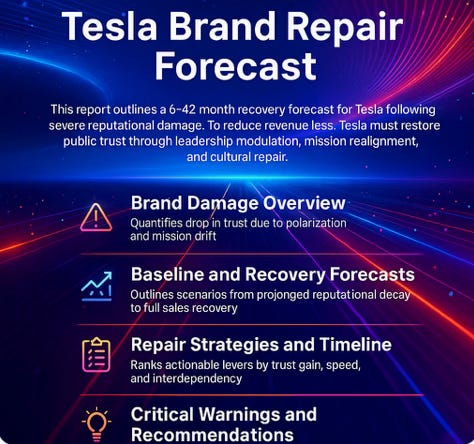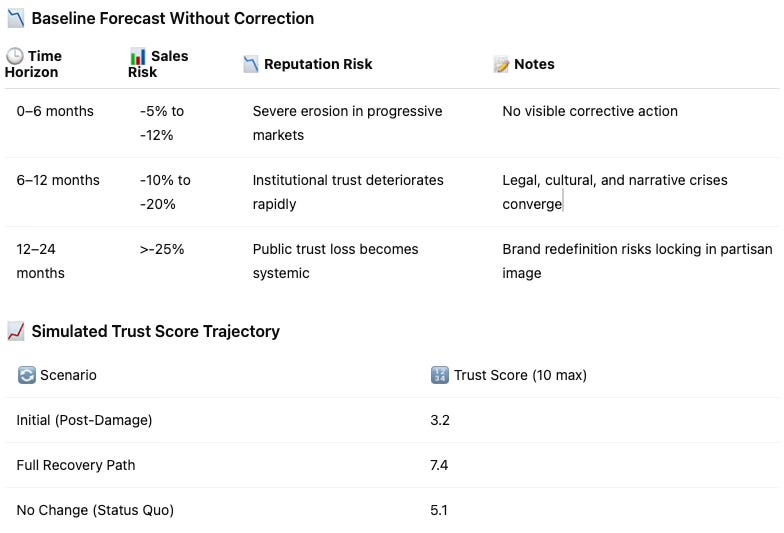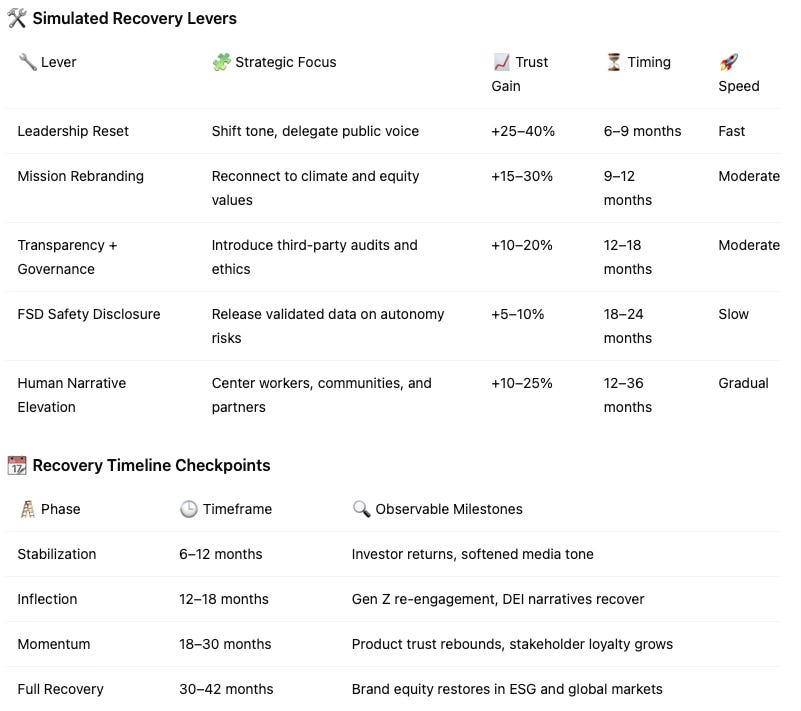MCAI Market Vision: Tesla Brand Repair Forecast
A Forecast of Sales and Reputation Recovery
I. Introduction and Brand Damage Overview
Tesla faces a 6–42 month recovery window to restore its brand and sales trajectory. This report offers a strategic assessment based on behavioral modeling of stakeholder sentiment and public response patterns. We use simulated consumer and investor profiles to analyze how leadership behavior, narrative alignment, and market trust evolve over time.
The brand has fractured due to mixed messaging, high-profile leadership controversies, and perceived abandonment of core environmental values. Damage extends beyond public relations into structural contradictions between promises and actions. When narrative and conduct diverge, public memory intensifies. Repair depends on re-establishing coherence between mission, leadership, and institutional behavior.
Insight: Tesla’s reputational crisis reflects a breakdown between internal behavior and public expectation. Coherence—between what the company says, does, and stands for—is essential to rebuild trust. Brands that align performance with purpose gain durable influence. Recovery starts with reconnection to shared values.
Key Damage Signals:
Founder Polarization: Elon Musk’s political extremism and unpredictable communication
Mission Drift: Disconnection from the climate-focused brand promise
Trust Collapse: Withdrawal by ESG investors, reputational fallout, generational alienation
Narrative Confusion: Innovation claims conflict with internal governance behavior
II. Quantifying the Damage and the Recovery Path
Trust and sales erosion is quantifiable based on recent market behavior, media sentiment, and institutional signals. Without reform, Tesla risks losing key customer segments and investor categories within 6–12 months. With reform, recovery is achievable, but contingent on early and visible structural changes. The timeline below reflects projected outcomes across a set of high-confidence scenarios.
These projections use weighted stakeholder sentiment data, historical recovery analogues, and scenario variance modeling. Public trust responds to perceived integrity, not intent. When credibility gaps widen, recovery requires more than rebranding—it demands proof of change. Timing, transparency, and tone set the conditions for reversibility.
Insight: Recovery becomes exponentially harder the longer the delay. Trust decays fast, rebounds slow. Alignment between values, voice, and visible change forms the foundation of reputational repair.
III. Strategic Levers for Recovery
Repair begins with clear signals: recalibrated leadership tone, renewed commitment to the original climate mission, operational transparency, and credible engagement with critics and employees. Structural reforms restore early momentum. Cultural alignment sustains the turn.
Each action must show not only intention but follow-through. Investors and consumers track how the company protects workers, honors values, and adjusts its public face. Recovery is not a communication strategy—it’s a systems strategy. The table below quantifies potential trust gains across coordinated interventions.
Insight: Recovery compounds when action and narrative reinforce each other. Cultural repair is a force multiplier, not a soft asset. Authentic leadership and public proof outperform spin. Brands recover when communities believe again.
IV. Contingency Risks and System Feedback Loops
Failure to evolve the leadership voice or mission coherence locks Tesla into narrative instability. Every quarter without correction calcifies reputational damage. The market reads silence as strategy. Brand erosion becomes embedded.
Contradictions between innovation goals and cultural dissonance generate long-tail risks. Without new cultural signals, even product breakthroughs struggle for traction. Reputation operates as a trust economy—losses compound, and rebuilds require systemic investment.
Insight: Decisive leadership action is the only way to reverse the feedback loop of brand distrust. When perception ossifies, performance loses influence. Reputational capital must be actively rebuilt, not assumed.
If Musk remains central without counterbalance:
Brand stagnates in high-cost, low-trust segments
Regulatory and institutional scrutiny intensifies
Cultural markets and younger consumers disengage long-term
V. Strategic Recommendations and Outcome Scenarios
Tesla must choose between reputation recovery and reputation attrition. The current window still allows a positive arc—if leadership coherence, product integrity, and stakeholder inclusion converge. Market trust responds to truth, not claims.
To rebuild enduring equity, Tesla should:
Install governance firewalls between CEO persona and product strategy
Reaffirm climate and equity pillars as operating principles
Publish quarterly transparency reports on progress and missteps
Give internal voices—engineers, women, workers—center stage
Align compensation and incentives with cultural and mission metrics
Insight: The future of Tesla depends not on vision but verification. Stakeholders await not another promise, but proof. Recovery begins when the company speaks less and listens more—and when what it shows earns back belief.
Prepared by Noel Le, Founder | Architect of MindCast AI LLC. www.linkedin.com/in/noelleesq/, noel@mindcast-ai.com
Appendix: Cognitive Digital Twin Analysis
Tesla the Brand (CDT: Institutional Architecture)
Core Identity Markers: Sustainability innovator, autonomy pioneer, brand-as-visionary
Observed Drift: Leadership voice overshadows product narrative, ESG divergence, cultural misalignment
Behavioral Signals:
Frequent leader-centered media cycles
Resistance to regulatory norms
Inconsistency between stated mission and internal governance
Predicted Evolution Without Repair:
Locked perception as volatile tech personality brand
Persistent regulatory scrutiny and mission skepticism
Brand equity concentrated in politically aligned or cult-driven consumer groups
Repair Path Activation:
Recenter engineering team in media and product communication
Establish governance buffer between public statements and brand
Reintroduce sustainability goals with third-party validation and public reporting
The Public (CDT: Consumer-Investor Culture)
Primary Segments:
Climate-driven consumers (Gen Z, EU buyers)
Institutional ESG investors
Middle-market skeptics
Trust Fracture Symptoms:
Emotional dissonance between values and leadership tone
Perceived betrayal of equity, labor, or transparency principles
Disengagement from younger consumer cohorts and European regulators
Cognitive Feedback Patterns:
Reactivity to leadership behavior outweighs appreciation of product roadmap
Narrative volatility triggers brand distancing
Stakeholders demand coherence before recommitment
Trust Rebuild Triggers:
Authentic inclusion of community voices and frontline workers
Measurable governance reform (e.g., board transparency, whistleblower protections)
Aesthetic and narrative reset led by engineers, not executives
Conclusion: The CDT analysis highlights systemic misalignment between Tesla’s internal identity and the cultural field it depends on for legitimacy. Rebuilding trust requires not only narrative consistency but also behavioral evidence that reinforces stakeholder values across every major public touchpoint.





